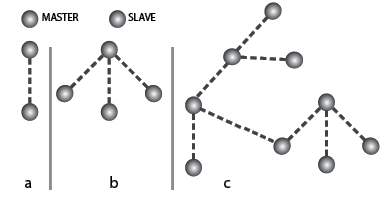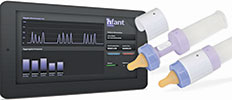
The market for wirelessly connected Internet of Things (IoT) devices is expected to grow explosively over the next few years, so developers are rushing to find the best platforms and tools with which to build their systems. But making the right choices can be challenging.
Connectivity options include Classic Bluetooth and Bluetooth Smart (also called Bluetooth Low Energy or BLE) for point-to-point, Wi-Fi for IP gateways, or ZigBee and Thread for mesh networks that enable machine-to-machine connections.
The fastest growing segments of the IoT are personal area networking (PAN) apps that give humans access to and control of the devices in their immediate environment or that they wear on their bodies. Because the protocol is already incorporated into virtually every mobile and smartphone, Bluetooth is the fastest and least expensive route to accomplish this objective. It provides users with a familiar and convenient connectivity option, and developers with a familiar set of building blocks.
Bluetooth allows developers to build IoT systems across a variety of applications and do so in the most cost effective manner on a platform flexible enough to meet varying operating constraints.
Bluetooth’s IoT building blocks
Bluetooth was originally developed as a wireless alternative to RS-232 data cables and point-to-point audio. Now managed and directed by the Bluetooth Special Interest Group (SIG), Bluetooth has evolved into a point-to-multipoint protocol typically supporting a few end-nodes on the same domain and operating over the 2,4 to 2,485 GHz spectrum to provide direct connections between two or more nodes – usually an end user and a ‘thing’ to be controlled or interrogated.
In Version 4.0, the standard was extended to support Bluetooth Smart as well as devices that can operate with Bluetooth Classic and also in BLE mode. Bluetooth 4.2 also introduced higher data rates with extended packet sizes as well as TCI/IP connectivity, making Bluetooth a great candidate for accessing networks seamlessly via access points among mobile phones.
Bluetooth Smart was incorporated into the main Bluetooth standard in 2010 with the adoption of the Bluetooth Core Specification Version 4.0 and operates over the same spectrum as Classic Bluetooth but uses it somewhat differently. Bluetooth Smart is designed to provide considerably reduced power consumption and cost while maintaining a similar communication range. Instead of the Classic Bluetooth specification’s seventy nine 1 MHz channels, Bluetooth Smart supports forty 2 MHz channels.
While Bluetooth Smart has been limited to bit rates of up to 1 Mbps, with a maximum transmit power of +10 dBm, Bluetooth Classic is capable of 4 Mbps and +20 dBm. Although Bluetooth Smart is not backward-compatible with Classic, the Bluetooth 4.0 specification permits devices to implement either or both of the Smart and Classic systems.
There has been decision in the Bluetooth SIG to allow +20 dBm transmit output power for Bluetooth Smart. When this becomes a reality, Silicon Labs is positioned to meet this requirement with Blue Gecko SoCs and modules that natively support up to +19,5 dBm output power. Bluetooth Smart is evolving even further and the 5.0 specification will significantly improve the receiver sensitivity, increasing the link budget to approximately 120 dB levels and potentially allowing Silicon Labs modules and SoCs to reach over 800 metre range.
Consumer/mobile IoT
Before the current focus on the IoT, the Bluetooth Advanced Audio Distribution Profile (A2DP) was, and still is, the de facto standard for streaming audio content with higher-quality external Bluetooth speakers. Building on that ubiquity, Bluetooth in its current Classic and Smart forms has been used for a variety of consumer IoT apps for location, positioning and advertising, linking the Bluetooth-enabled smartphone to external beacons.
Bluetooth beacons are revolutionising human-thing interactions, for example, when we shop in large retail stores and shopping malls. Many of us already use smartphones in stores for online comparison shopping. Using a smartphone’s Bluetooth connection, direct interaction between consumers and the things they want to buy in stores will soon be possible. These beacons primarily enable indoor positioning and the end user’s smartphone application feeds relevant information to the user in that area.
In addition to beaconing, Bluetooth Smart has become one of the main wireless methods for linking smartphones and wearable IoT devices. This includes not only smartwatches and fitness trackers but a variety of quirky offerings such as self-adjusting belts, gesture-tracking rings, mood-trackers, and personal devices clipped or embedded in clothing.
Easy Bluetooth IoT development
One reason for the increased number of human-in-the-loop, smartphone–based Bluetooth IoT designs is the wealth of easy-to-use software tools available. On the smartphone side, companies such as Apple and Google provide familiar and mature tools for developing the software apps needed to access external Bluetooth IoT devices.
On the IoT device side, members of the Bluetooth SIG actively provide tools to accelerate development of software needed to communicate with a smartphone or any other Bluetooth-enabled receiver. This includes support for not only the same languages and building blocks provided for development on the smartphone itself, but a number of programming tools based on familiar Web development tools. In addition, Bluetooth scripting languages with syntax and grammar very similar to ordinary human language are now available.
This ease of development is fuelling widespread Bluetooth use in areas outside consumer wearable apps, such as in automotive, home automation and networking, factory and building automation, and diverse medical applications.
Bluetooth IoT in vehicles

Bluetooth has established a presence in many new automotive designs as a part of infotainment systems. In a Bluetooth-enabled vehicle (Figure 1), the infotainment subsystem can easily interconnect a variety of portable devices such as DVD, CD, MP3 players and speakers, as well as provide access to a vehicle’s onboard diagnostic and control systems.
Other automotive apps enabled by Bluetooth include remote starting to warm up the car in the winter or turning on the air conditioning in summer, remote parking, home garage door controllers, payment for fuel at the pump and for toll roads, and wireless entry. Bluetooth is also making its way into engine control, vehicle body electronics and the anti-lock braking safety subsystem.
Battery management
Bluetooth IoT is being used for battery management in hybrid and electric vehicles, where battery packs of many individual battery cells operate reliably only when all of the individual cells charge/discharge in unison. Current technology relies on thousands of wired sensor connections to track temperature and voltage of each cell and adjust charge and discharge rates accordingly. These wired connections are susceptible to failure. Bluetooth connectivity minimises the failure points and makes individual components more readily replaced without an entire battery rebuild.
Replacing the wiring harness
As the number of electronic devices and applications in vehicles keeps increasing, the amount of wiring needed for the connection of sensors has also increased. Auto makers are now looking to wireless technologies such as Bluetooth to reduce the cost and weight of wiring. A recent study by General Motors and Carnegie Mellon proposes a new wireless architecture based on Bluetooth Smart to achieve this goal. Not only can Bluetooth Smart help reduce cost and weight, tests have shown that it can provide the throughput needed in many wiring harness replacement applications.
Bluetooth anti-lock braking
Bluetooth is being considered in automobile anti-lock braking systems in combination with FlexRay vehicle networks for x-by-wire control systems. In such designs, an ABS monitoring application would use an Android smartphone to receive information from Bluetooth transmitters in a FlexRay system used to monitor such things as wheel speeds and brake slippage.
Automating the home with Bluetooth
Because of its ubiquitous smartphone integration, Bluetooth has become a popular wireless connectivity option for IoT-based home networking and automation.
Scatternet for home automation
In a recent smartphone-based, Bluetooth Smart home automation design, Bluetooth-enabled adaptors control the power supply of many non-network enabled devices such as lamps, coffeemakers and other home appliances.
The appliances interact with the smartphone and each other through a hybrid mesh network that transforms multiple Bluetooth point-to-point connections into a scatternet (Figure 2) in which one device in each Bluetooth hub also participates as a slave in another piconet, enabling messages to be relayed between each hub and its devices.

Bluetooth for home energy management
To address the diverse power management needs of various electrical appliances in the home, a recent application of Bluetooth Smart makes use of a fuzzy logic controller (FLC) in a home energy management (HEM) design that deals with the variability in the power needs of appliances and their loads in different hours of the day. Using Bluetooth Smart-enabled smart plugs, the system monitors peak and off-peak power usage and suggests ways to modify the use of an electrical device to lower overall power consumption.
Industrial Bluetooth
Bluetooth beaconing applications have a lot of potential in the modern, highly automated industrial environment and in building automation. In such environments one person is often responsible for the operation of many machines. Via Bluetooth’s point-to-point connections, industrial workers with smartphones can interrogate or receive reports from equipment incorporating Bluetooth tags.
Bluetooth is well suited for industrial application scenarios where limited bursts of data must be delivered in real time in a noisy environment. In a typical wireless smart sensor platform, Bluetooth can support the hardware interface, payload and communications needs of multiple inertial and position sensors, as well as actuators/motors used in instrumentation systems and predictive maintenance applications. Such designs also provide a means to change operating and monitoring parameters via specific firmware modules as over-the-air updates using Bluetooth’s point-to-point topology.
Bluetooth in medical/health IoT
One of the biggest IoT growth areas for Bluetooth is expected to be PAN-enabled individual health metrics collection through wearable sensor patches, wirelessly-enabled scales and a myriad of other bio-sensing applications.
Beyond the wellness apps developed for use on smartphones and in wearable devices, Bluetooth is being deployed in hospitals and for use by medical professionals and their patients. Among the many IoT-related applications: management of movable resources such as beds and medical equipment, patient monitoring, data logging, collecting sensor information from patients and wearable body area networks for intensive care.
Monitoring the heart
In a typical medical monitoring system, sensors incorporated into a shirt gather ECG information and send it to a coin-sized Bluetooth transmitter. From there, it is transferred to the patient’s Android smartphone where an onboard app displays it for immediate review and also sends it to an external server for storage where the patient and/or physician can access and review it.
Monitoring preemies

Bluetooth Smart is being used by nfant in its ‘electronic nipple’ product (Figure 3) to measure and transmit data collected by a Bluetooth Smart-enabled baby bottle. It collects information on how often and how vigorously premature babies suck on it to feed and sends the data to a monitoring unit. That data aids in determining when it is safe to release a baby from intensive care.
Making Bluetooth IoT more ubiquitous
While Bluetooth Smart is not backward-compatible with Classic, the Bluetooth SIG has gone a long way toward making the use of one or the other, or both, in a design as easy as possible. Many wireless IoT apps work in environments in which the same system may have different requirements on the transmit side and the receive side. The Bluetooth 4.0 specification permits devices to implement either or both of the Bluetooth Smart and Classic systems.
Many Bluetooth technology suppliers have introduced a number of hardware and software building blocks to simplify Bluetooth design. For example, pre-certified Bluetooth Classic, Smart and Smart Ready modules are available to help simplify the process of adding Bluetooth connectivity to IoT applications. These modules provide developers with everything they need, including the radio, microcontroller, antenna and Bluetooth stack in an easy to implement plug-and-play solution. Numerous software programming tools including easy-to-use scripting languages are available to speed development.
For example, the BGM111 Bluetooth Smart module from Silicon Labs includes a high-performance 2,4 GHz wireless SoC and is pre-loaded with Bluetooth 4.1-compliant software stack and profiles. Silicon Labs also provides developers with the flexibility to begin Bluetooth Smart development with BGM111 modules and then transition to the company’s Bluetooth Smart SoCs when needed, with minimal system redesign and full software reuse.
On the software side, Silicon Labs’ Bluetooth modules are supported by a range of software tools, including a custom binary protocol used to externally control the module and a profile toolkit for creating a generic attitude profile for sending and receiving short pieces of data over low-energy links. Also included is an ANSI C reference implementation of the Bluetooth binary protocol, as well as the company’s BGScript scripting language, which allows developers to write software in a BASIC-like interpretive programming language, which can then be compiled for use in a Bluetooth application.
For more information contact NuVision Electronics, +27 (0)11 608 0144, [email protected], www.nuvisionelec.com
| Tel: | +27 11 608 0144 |
| Email: | [email protected] |
| www: | www.nuvisionelec.com |
| Articles: | More information and articles about NuVision Electronics |

© Technews Publishing (Pty) Ltd | All Rights Reserved